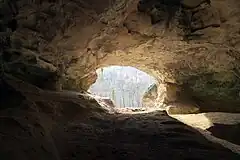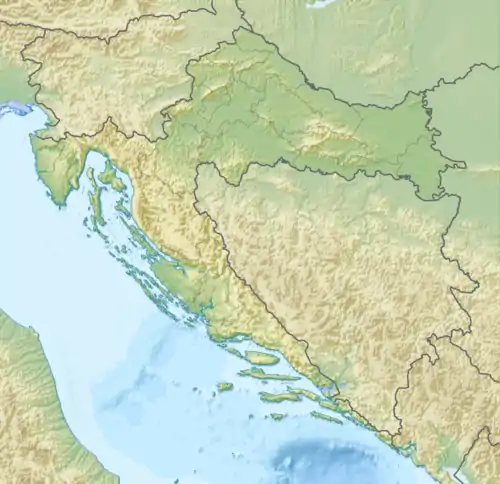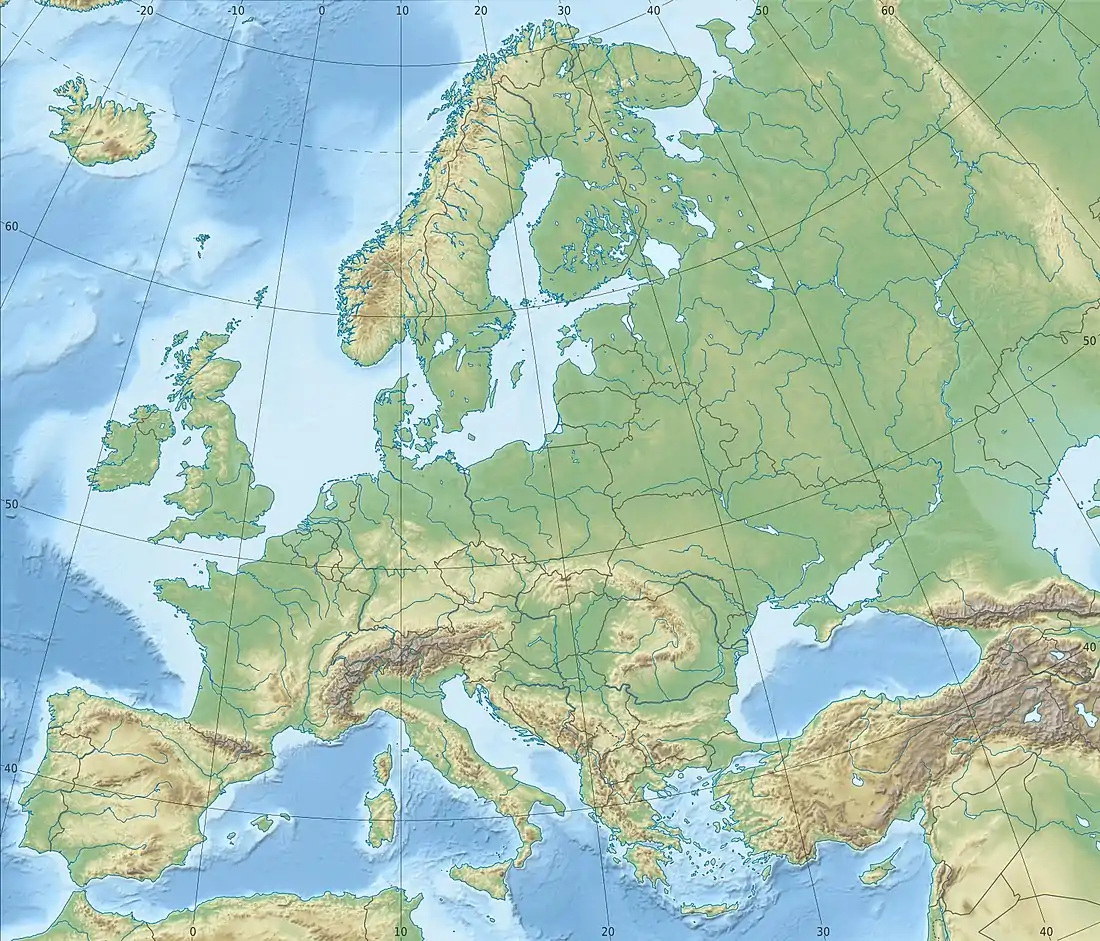 Vindija Cave | |
 Shown within Croatia  Vindija Cave (Europe) | |
| Location | Donja Voća |
|---|---|
| Region | Hrvatsko Zagorje |
| Coordinates | 46°17′57″N 16°4′14″E / 46.29917°N 16.07056°E |
| Length | 50 metres (160 ft)[1] |
| Width | 28 metres (92 ft)[1] |
| Height | 20 metres (66 ft)[1] |
| History | |
| Periods | Paleolithic |
| Associated with | Neanderthals, Paleo-humans |
| Site notes | |
| Archaeologists | Mirko Malez |
Vindija Cave is an archaeological site associated with Neanderthals and modern humans, located in the municipality of Donja Voća, northern Croatia. Remains of three Neanderthals were selected as the primary sources for the first draft sequence of the Neanderthal genome project in 2010.[2] Additional research was done on the samples and published in 2017.
Description
The cave is located roughly 20 km (12 mi) west of the city of Varaždin and 10 km (6.2 mi) north of Ivanec. It is estimated that Neanderthals used the cave 40,000 years ago; approximately 8000 years before modern humans lived in that part of Europe.[3]
The hominid specimens at level 3G are regarded as unquestionably Neanderthal in overall morphology but exhibit a number of traits that sit closer to anatomically modern Europeans than to the traditional Neanderthal. These include a thinner and less projecting brow ridge, reduced facial size, and narrower front teeth.[4] Though some have put these differences down to the small size of the Vindija individuals, a study conducted in 1995 established that the Vindija Neanderthals, though small, were of comparable size to more morphologically classic Neanderthals such as La Ferrassie 2, Shanidar 1 and 4, and Tabun 1. More likely, the Vindija Neanderthals were in transition from the classic robust form to a more gracile one.[5]
Dating
The Neanderthal remains at Vindija were found in a Mousterian context; some of the remains occurred in a level with some mixed Aurignacian artefacts.[1] Several of the Neanderthal samples from Vindija also yielded surprisingly late dates when directed dated, yielding dates as late as 28,000–29,000 BP. This led to suggestions that Neanderthals might have survived longer than previously thought and that the Neanderthals at Vindija might have lived concurrently with modern humans.[6] However, later dating methods using more advanced techniques revealed that these earlier dating results were erroneous. The erroneous dates were due to contamination by modern carbon, as minute amounts of modern contamination may result in large errors for very old samples.[7]
In 2017, researchers from the Oxford Radiocarbon Accelerator Unit applied a new technique using AMS ultrafiltration based on the extraction of hydroxyproline to directly date several samples from Vindija Cave. Their direct AMS dating results show that the Neanderthal finds at Vindija are older than 44,000 BP. Since this is earlier than the arrival of the first modern humans to the region, the Vindija Neanderthals most likely did not intermix with modern humans.[6]
Archaeogenetics
In 2010, the first draft sequence of the Neanderthal genome was reconstructed primarily from three low coverage genomes from Vindija Cave, taken from Vindija 33.16, Vindija 33.25 and Vindija 33.26.[2]
Prüfer et al. (2017) sequenced a high coverage genome from Vindija 33.19. At around 30-fold coverage, Vindija 33.19 is the second high coverage Neanderthal genome to be sequenced, after the Altai Neanderthal from Denisova Cave.[6] In 2018, researchers sequenced a low coverage genome from an undiagnosed bone fragment, Vindija 87 (directly dated to around 47,000 BP) and concluded that the fragment most likely came from the same individual as Vindija 33.19.
Devièse et al. (2017) applied collagen peptide mass fingerprinting, and Zooarchaeology by Mass Spectrometry (ZooMS), to sort through several unidentified fossil fragments recovered from Vindija Cave. They successfully identified a new Neanderthal fossil fragment, Vindija *28. Most of the fossil fragments that were identifiable by ZooMS were classified as belonging to Ursus.[8] This was confirmed by Slon et al. (2017) who tested a soil sample from Vindija for mitochondrial DNA (mtDNA). Most of the classifiable mtDNA was ascribed to Ursus, coming predominately from Ursus ingressus.[9]
Hajdinjak et al. (2018) found that the individuals Vindija 33.16, Vindija 33.25, Vindija 33.26 and Vindija 33.19, were genetically closest to each other than any other Neanderthal individuals on record. DNA analysis revealed that Vindija 87, and thus most likely Vindija 33.19, was female. [10] The Vindija Neanderthals were also found to be genetically closer to other late European Neanderthals, to the exclusion of the Mezmaiskaya Neanderthals from Mezmaiskaya cave in the Caucasus.
Modern humans share more alleles with Vindija 33.19 and Mezmaiskaya 1 than with the Altai Neanderthal. With the addition of the Vindija 33.19 genome, researchers revised upwards the percentage of human DNA in non-Africans introgressed from Neanderthals and were able to identify additional phenotypic variants in humans that are derived from Neanderthals.[6]
See also
References
Citations
- 1 2 3 4 Janković et al. 2011.
- 1 2 Green et al. 2010.
- ↑ Price, Michael (4 September 2017). "Neandertals and early modern humans probably didn't meet at rumored rendezvous site". Science. doi:10.1126/science.aap8521. Retrieved 2 June 2022.
- ↑ Wolpoff et al. 1981.
- ↑ Trinkaus & Smith 1995.
- 1 2 3 4 Prüfer et al. 2017.
- ↑ Hublin 2017.
- ↑ Devièse et al. 2017.
- ↑ Slon et al. 2017.
- ↑ Hajdinjak et al. 2018.
Bibliography
- Devièse, Thibaut; Karavanić, Ivor; Comeskey, Daniel; Kubiak, Cara; Korlević, Petra; Hajdinjak, Mateja; Radović, Siniša; Procopio, Noemi; Buckley, Michael; Pääbo, Svante; Higham, Tom (2017). "Direct dating of Neanderthal remains from the site of Vindija Cave and implications for the Middle to Upper Paleolithic transition". Proceedings of the National Academy of Sciences. 114 (40): 10606–10611. doi:10.1073/pnas.1709235114. ISSN 0027-8424. PMC 5635904. PMID 28874524.
- Green, R. E.; Krause, J.; Briggs, A. W.; Maricic, T.; Stenzel, U.; Kircher, M.; Patterson, N.; Li, H.; Zhai, W.; Fritz, M. H. Y.; Hansen, N. F.; Durand, E. Y.; Malaspinas, A. S.; Jensen, J. D.; Marques-Bonet, T.; Alkan, C.; Prufer, K.; Meyer, M.; Burbano, H. A.; Good, J. M.; Schultz, R.; Aximu-Petri, A.; Butthof, A.; Hober, B.; Hoffner, B.; Siegemund, M.; Weihmann, A.; Nusbaum, C.; Lander, E. S.; Russ, C.; Novod, N.; Affourtit, J.; Egholm, M.; Verna, C.; Rudan, P.; Brajkovic, D.; Kucan, Z.; Gusic, I.; Doronichev, V. B.; Golovanova, L. V.; Lalueza-Fox, C.; de la Rasilla, M.; Fortea, J.; Rosas, A.; Schmitz, R. W.; Johnson, P. L. F.; Eichler, E. E.; Falush, D.; Birney, E.; Mullikin, J. C.; Slatkin, M.; Nielsen, R.; Kelso, J.; Lachmann, M.; Reich, D.; Paabo, S. (2010-05-06). "A Draft Sequence of the Neandertal Genome". Science. American Association for the Advancement of Science (AAAS). 328 (5979): 710–722. Bibcode:2010Sci...328..710G. doi:10.1126/science.1188021. ISSN 0036-8075. PMC 5100745. PMID 20448178.
- Hajdinjak, Mateja; Fu, Qiaomei; Hübner, Alexander; Petr, Martin; Mafessoni, Fabrizio; Grote, Steffi; Skoglund, Pontus; Narasimham, Vagheesh; Rougier, Hélène; Crevecoeur, Isabelle; Semal, Patrick; Soressi, Marie; Talamo, Sahra; Hublin, Jean-Jacques; Gušić, Ivan; Kućan, Željko; Rudan, Pavao; Golovanova, Liubov V.; Doronichev, Vladimir B.; Posth, Cosimo; Krause, Johannes; Korlević, Petra; Nagel, Sarah; Nickel, Birgit; Slatkin, Montgomery; Patterson, Nick; Reich, David; Prüfer, Kay; Meyer, Matthias; Pääbo, Svante; Kelso, Janet (2018). "Reconstructing the genetic history of late Neanderthals". Nature. 555 (7698): 652–656. Bibcode:2018Natur.555..652H. doi:10.1038/nature26151. ISSN 0028-0836. PMC 6485383. PMID 29562232.
- Hublin, Jean-Jacques (2017). "The last Neanderthal". Proceedings of the National Academy of Sciences. 114 (40): 10520–10522. doi:10.1073/pnas.1714533114. ISSN 0027-8424. PMC 5635937. PMID 28973864.
- Janković, Ivor; Karavanić, Ivor; Ahern, James C. M.; Brajković, Dejana; Lenardić, Jadranka Mauch; Smith, Fred H. (2011). "Archaeological, Paleontological and Genomic Perspectives on Late European Neandertals at Vindija Cave, Croatia". In Condemi, Silvana; Weniger, Gerd-Christian (eds.). Continuity and Discontinuity in the Peopling of Europe: One Hundred Fifty Years of Neanderthal Study. Dordrecht: Springer Netherlands. doi:10.1007/978-94-007-0492-3_23. ISBN 978-94-007-0491-6. ISSN 1877-9077.
- Prüfer, Kay; de Filippo, Cesare; Grote, Steffi; Mafessoni, Fabrizio; Korlević, Petra; Hajdinjak, Mateja; Vernot, Benjamin; Skov, Laurits; Hsieh, Pinghsun; Peyrégne, Stéphane; Reher, David; Hopfe, Charlotte; Nagel, Sarah; Maricic, Tomislav; Fu, Qiaomei; Theunert, Christoph; Rogers, Rebekah; Skoglund, Pontus; Chintalapati, Manjusha; Dannemann, Michael; Nelson, Bradley J.; Key, Felix M.; Rudan, Pavao; Kućan, Željko; Gušić, Ivan; Golovanova, Liubov V.; Doronichev, Vladimir B.; Patterson, Nick; Reich, David; Eichler, Evan E.; Slatkin, Montgomery; Schierup, Mikkel H.; Andrés, Aida; Kelso, Janet; Meyer, Matthias; Pääbo, Svante (2017). "A high-coverage Neandertal genome from Vindija Cave in Croatia". Science. 358 (6363): 655–658. Bibcode:2017Sci...358..655P. doi:10.1126/science.aao1887. ISSN 0036-8075. PMC 6185897. PMID 28982794.
- Slon, Viviane; Hopfe, Charlotte; Weiß, Clemens L.; Mafessoni, Fabrizio; de la Rasilla, Marco; Lalueza-Fox, Carles; Rosas, Antonio; Soressi, Marie; Knul, Monika V.; Miller, Rebecca; Stewart, John R.; Derevianko, Anatoly P.; Jacobs, Zenobia; Li, Bo; Roberts, Richard G.; Shunkov, Michael V.; de Lumley, Henry; Perrenoud, Christian; Gušić, Ivan; Kućan, Željko; Rudan, Pavao; Aximu-Petri, Ayinuer; Essel, Elena; Nagel, Sarah; Nickel, Birgit; Schmidt, Anna; Prüfer, Kay; Kelso, Janet; Burbano, Hernán A.; Pääbo, Svante; Meyer, Matthias (2017). "Neandertal and Denisovan DNA from Pleistocene sediments". Science. 356 (6338): 605–608. Bibcode:2017Sci...356..605S. doi:10.1126/science.aam9695. hdl:1887/74733. ISSN 0036-8075. PMID 28450384.
- Trinkaus, Erik; Smith, Fred H. (1995). "Body size of the Vindija Neandertals". Journal of Human Evolution. Elsevier BV. 28 (2): 201–208. doi:10.1006/jhev.1995.1015. ISSN 0047-2484.
- Wolpoff, Milford H.; Smith, Fred H.; Malez, Mirko; Radovčić, Jakov; Rukavina, Darko (1981). "Upper Pleistocene Remains from Vindija Cave, Croatia, Yugoslavia" (PDF). American Journal of Physical Anthropology. 54: 499–545. doi:10.1002/ajpa.1330540407. hdl:2027.42/37603.
External links
- Marina Biluš (11 September 2007). "Tajne evolucije iz špilje Vindije" [Secrets of evolution from the Vindija Cave]. Nacional (in Croatian). No. 617. Archived from the original on 24 March 2012. Retrieved 15 July 2019.
- Špilja Vindija Archived 2010-01-22 at the Wayback Machine (in Croatian)
- Video about Vindija on YouTube
- Dekodiran DNK neandertalca iz špilje Vindija Archived 2010-05-22 at the Wayback Machine (in Croatian)